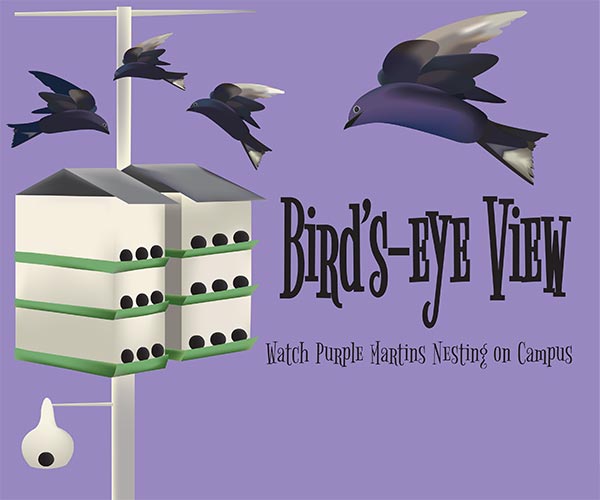BIRD’S-EYE VIEW: Watch purple martins nesting on campus

Ashley Honc
The Signal
UHCL is recognized by the Environmental Institute of Houston for having an environmentally friendly campus and protecting the nature and wildlife inhabiting it.
The purple martin habitat located in front of the North Office Annex Building was built in an effort to raise environmental consciousness through education.
Sheila Brown, habitat curriculum specialist, got the idea to build the bird nest on campus while attending a meeting at the Wild About Birds nature store years ago.
“I wanted the kids [Clear Lake High School Earth Club] to learn about the purple martins, and so they started by cleaning the housing and placing pine needles in the compartments by Valentine’s Day each year,” Brown said.
Hurricane Ike took down the original multihouse dwelling for the martins. What stands now is larger colony housing with 22 total nests that was funded by the school and Matt Fendly, academic computing systems coordinator, who constructed the birdhouse.
What makes this birdhouse unique from others in the area is a miniature live streaming camera recently placed on the inner wall of one of the compartments housing a nest.
“The camera was installed to bring more attention to the purple martins and allow school kids to monitor the nesting progress from any computer,” said Fendley, who also manages and keeps the birdhouse operational.
Purple martins are migratory birds that nest in North America and travel to South America, typically Brazil, during the winter. From UHCL, this journey is roughly 4,900 miles one way.
“2008 was the first year with purple martins nesting at UHCL,” Fendley said. “They have been returning every year since.”
During migration, if their previous nest was managed properly, they will come back to it and continue to nest there every year during their lifespan. If damaged or gone when they return, they will relocate up to 50 miles away.
The purple martins that are nesting with the live camera were housed there last year as well.
“As long as they successfully raised babies the previous season, the adults will always return to their same nesting grounds,” Fendley said.
Purple martins are secondary-cavity nesters. This means they are dependent on human housing or previously used nests.
Fendley started the construction of the nests at UHCL with pine needles. The martins will then add elements of their own including mud and leaves.
With spring being the martins’ nesting season, any time now on the nest cam, you will begin to see the egg-laying process. The female martin will begin to lay one egg a day; the total amount of eggs laid ranges from two to seven. Approximately 15 days later they will begin to hatch.
Once the baby martins hatch, both parents continue to feed their young until they start to fly, roughly a month after hatching. Approximately two weeks after their first flight, they will continuously come back to their birthplace to feed from their parents and sleep at night.
Two of the purple martins’ leading predators are the English house sparrow and the European starling. Both are aggressive birds that will sabotage purple martin eggs when the parents are away from the nest and/or take over their housing.
“Purple martins, like all songbirds, can be victims of isolated predation (raccoons, snakes, hawks, and owls), but this pales in comparison to the toll taken on the purple martins’ numbers, due to the loss of available housing, thanks to the aforementioned sparrows and starlings,” Fendley stressed.
Precautions have already been taken so that this doesn’t happen to the UHCL colony.
“We prevent the starlings from nesting there by using special starling-resistant entrances that block them from entering the nest,” Fendley said.
Students are welcomed and encouraged to visit the purple martin birdhouse located north of parking lot D4. The live video camera inside the nest is also an alternative way to keep up with the reproduction cycle of the martins on campus.
“We will keep the camera live until the last martin nest has finished and there are no more staying the night in any of the compartments,” Fendley said.
To advance further study of the purple martins, Fendley hopes to get tracking devices for the birds on campus.
“I would love to have geo-locators or bands to track the martins here and during migration,” Fendley said.
To view the purple martins live nest cam, visit http://prtl.uhcl.edu/portal/page/portal/EIH/video.


RT @UHCLTheSignal: BIRD’S-EYE VIEW: Watch Purple Martins Nesting on Campus: http://t.co/CtS0hAyV77